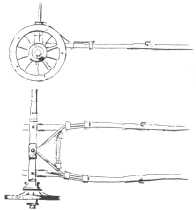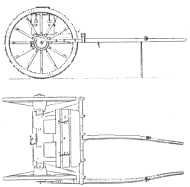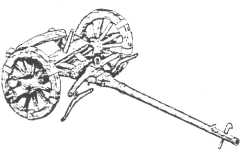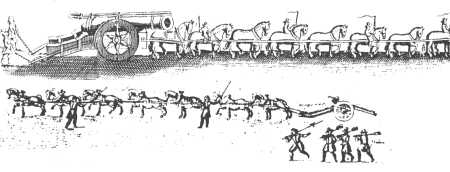The Gun - Carriages: LimberUntil the limber was invented, mobile gun carriages were pulled muzzle-first - with their trails literally trailing on the ground - by a number of horses either in single file or in pairs. Then it was found they travelled better if pulled trail-first, and they did not require the use of 'sled feet' men. A contemporary writer described the change as 'progress'.
Even after the introduction of the limber the methods of moving artillery equipments lived on in some countries, notably England, for many years. Limbers do not appear to have been used in that country before 1663. A single trail wheel came into use about 1650, but was used only on the gun position, not for travelling. It was known as the 'Hanoverian truck'. The reasons for delay in adopting the limber in England - as well as other new ideas - were threefold: first, the army was generally neglected, as the efficiency of the navy precluded any chance of invasion of the country. Secondly, until 1716 a train of artillery formed at the start of a campaign was disbanded at the end of it, the Gunners discharged, and the equipment returned to store where it lay forgotten until the next war. Finally, there existed an innate conservatism among the Officers, many of whom hated change in any form. Limber Shafts
| ||
 Early shaft-draught limber. |
 British limber with off-set shafts. |
 Pole draught limber c. 1650. |
|
However, the method was suitable only for lighter guns, eg 3- and 6-prs. In order to facilitate the use of horses in pairs for the heavier equipments Britain adopted a system in which the shafts were offset, ie the off shaft was connected to the axle at the off limber wheel, while the near shaft was connected to the centre of the limber. Whatever the system, shaft draught proved less than satisfactory because firstly the shaft horse had to have a different set of harness from the others. Secondly, because early limber wheels were smaller than the gun wheels, the angle formed by the shafts and the traces of the leading horses caused the shafts to be pulled downward, thus making life difficult for the shaft horse. The fitting of the limber wheels the same size as gun wheels eased the strain on the shaft horse to some extent but only partially solved the problem. Consequently, by about the middle of the 17th century nations on the Continent had adopted pole draught. In this system the harness of all horses was virtually the same, and no additional load was placed on the wheel horses (formerly the shaft horse). Although used in India and New Zealand with bullocks during the 1860s, pole draught was not universally adopted by Britain until 1895. The pole was used until mechanisation. It was then replaced by the engine draught connector. For some unknown reason, after mechanisation the limber becmae known as the 'trailer'. .../Mechanisation WL Ruffell previous | index | next | History index | Home | ||

 First called the 'fore-carriage', the earliest description of a limber occurs - strangely enough - in an English paper dated 1497, while the oldest illustration fitting the description is a German etching dated 1518. It consists simply of two wheels, an axletree with a pintle for attachment of the trail, plus a draught connector to which one or two swingletrees might be attached. Evidently the draught system was not successful for it was soon superseded by 'shaft draught', ie two shafts between which a horse was harnessed, connected directly to the front of the limber. Additional horses were hooked in ahead of the shaft horse.
First called the 'fore-carriage', the earliest description of a limber occurs - strangely enough - in an English paper dated 1497, while the oldest illustration fitting the description is a German etching dated 1518. It consists simply of two wheels, an axletree with a pintle for attachment of the trail, plus a draught connector to which one or two swingletrees might be attached. Evidently the draught system was not successful for it was soon superseded by 'shaft draught', ie two shafts between which a horse was harnessed, connected directly to the front of the limber. Additional horses were hooked in ahead of the shaft horse.